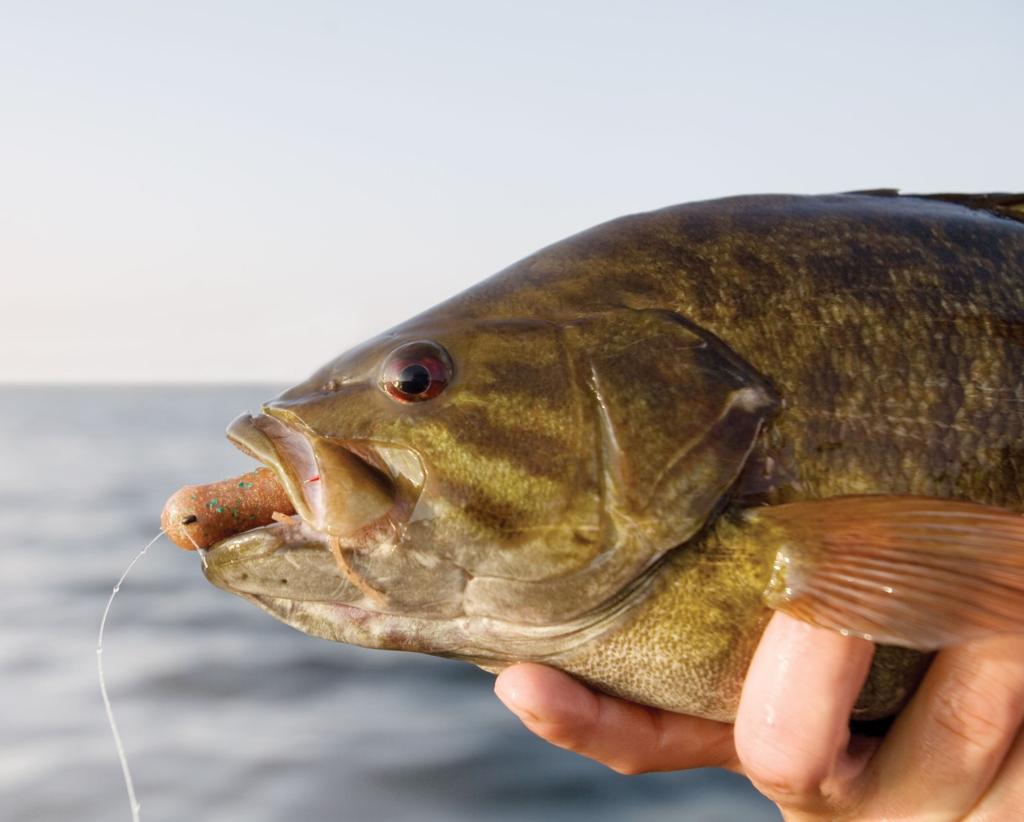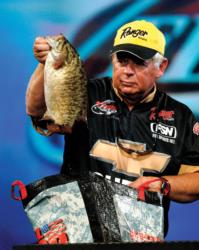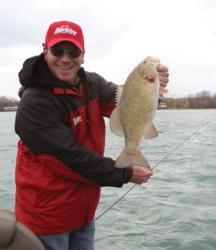Spot-on tubing
Catch Lake Erie smallmouths on tubes after the 40-degree switch

To say I was looking forward to fishing with The General was an understatement. On my drive up to Lima, Ohio, to meet Steve Clapper, thoughts of multiple 5-pound smallmouths admittedly caused my mind to wander at times. Thankfully, the effects on my driving were minimal, and I arrived safely. The only hitch to the fishing would be navigating Lake Erie and all the pleasantries it can provide on an early April outing.
I’d seen what Lake Erie had to offer shortly after ice-out the season before. Fishing with Joe Balog of Harrison Township, Mich., FLW Outdoors Magazine Editor Jason Sealock and I hooked into 4-pounder after 4-pounder, with a few 5-pounders mixed in while fishing with blade baits, hair jigs and drop-shot-rigged gobies. Balog predictably administered poundings on both of us from the front of the boat.
Lake Erie can produce early season smallmouthing bordering on divine, and Clapper had been in the business of teaching the big bronzebacks daily lessons longer after the turn-of-the-year ice-out than most. In fact, Balog credited the salty pro for much of what he knows. And even though Clapper has been fishing tournaments longer than some of his competitors have been potty trained, he’s still very capable of navigating the oft-treacherous waters of the Great Lake and bringing home the goods – such as when he won the final Wal-Mart FLW Tour event of 2007 on Erie and cashed a $200,000 check.
He departed from the launch ramp at Port Clinton, Ohio, and headed for one of his favorite offshore rock piles. He has a formula for smallmouths at that time of year. The water temperature is usually in the high 30s, and the bass will be staging in predictable areas, often in 20 feet or so of water adjacent to spawning flats. Find them in these areas, present them with the right baits, and despite the frigid water, the frequency of the action can be akin to sitting over a bed of bluegills.
He began the morning’s work after kicking a buoy atop the rock pile. The wind hadn’t seemed like much when he launched, but as I attempted to hold the boat in place via the long-shaft Minn Kota while Clapper rigged some tackle, I realized boat control while in 4-footers – modest waves for Lake Erie – was a skill in and of itself.
He fished the rock pile for a while, which was in excess of 20 feet deep, with nary a strike. Clapper kept eyeing the temperature gauge on his electronics. The water was 45 degrees. “I can’t believe it’s already this warm out here,” the pro said.
He checked a few other rock piles in similar depth ranges before settling into some more protected water on the lee side of an island. Clapper had a hunch; motoring over a rock pile in shallower water, around 14 feet, he found what he was looking for – arches on the graph. “There they are,” he smiled, unrolling the weight on a buoy. Shortly afterward, he cast a smoke tube rigged on an inserted jighead and reeled it slowly in, keeping his rod at a near-perfect 45-degree angle. A few repetitive motions of this led to him suddenly setting the hook. A 3-pound smallmouth lumbered toward the surface in the cold water. It was the first of many to come over the next two days while fishing the same type pattern, and a half-dozen 5-pounders sweetened the deal.
 Clapper’s hunch to change to shallower water was really not a hunch at all. Like other Erie veterans, he knew that when the water temperature topped 40, it was time to make a switch to shallower water. Obviously, the switch paid off.
Clapper’s hunch to change to shallower water was really not a hunch at all. Like other Erie veterans, he knew that when the water temperature topped 40, it was time to make a switch to shallower water. Obviously, the switch paid off.
Following bronzebacks
The extreme early season on Erie and the treasures it can produce have been well-documented in the pages of FLW Outdoors Magazine. Drop-shot gobies, blade baits and hair jigs are the standard producers, but as smallmouths begin to take the next step from that water depth and temperature range, they stage over rock piles in slightly shallower water, and for whatever reason, become really angry when soft-plastic tubes are dragged by them.
“The magic number to really find them ganged up in that deep water is 37 degrees,” Clapper said. “And that’s usually a hair-jig or blade-bait bite. But when that water bumps 40, it’s a definite switch. You can still catch a handful here and there out deep, but they tend to be smaller. When we were fishing and didn’t find them out deep, I was surprised because it was so early in the year. But then we moved in shallower, and they were in there real well.”
Many smallmouths won’t move far from these areas, if they move away from them at all, once the spawn begins. Depending on the water clarity, smallmouths have no qualms about nesting in deep water. “Over around Buffalo, N.Y., where the water is a lot clearer, they’ve gotten them on camera spawning down in 25 feet of water,” Clapper continued.
Mike Trombly, another Lake Erie ace from Perrysburg, Ohio, believes a few of the largest smallmouths actually begin spawning in the mid-40-degree temperature range. “I think the biggest females, even when the water is down in the 40s, are spawning.” Trombly said. “It doesn’t have to be the textbook 55 degrees. I can’t see them and am not targeting them as bedding fish, but just by their behavior, I can tell some of them are on the bed. Usually around the first full moon in April, in the days leading up to it, during and just after it, the fishing can be tremendous. The largest fish will move into those shallow bays, sort of like a little sorority group. Those fish are always within 3/4 pound of one another – they’re usually the biggest fish of the year.”
Spawning or not, the fish definitely seem to prefer the calmest pockets of water. The lee sides of islands are always worthwhile places to look. “That time of year, they get into the tiniest of areas,” Trombly said, “but it has to be calm. Heavy waves will kill the bite. I’m just looking for the bays with the most protection and the most sunlight. Bays on the north will be good if the wind is blowing from the south, and bays on the south will be good if wind is from the north. Protection is first and foremost.”
Casting over drifting
 Drift-fishing with tubes, particularly in the summertime, is a productive way to put bass in the boat. However, many of the best Lake Erie anglers, Clapper, Trombly and Balog included, prefer a more targeted approach to the random drift-and-drag methods.
Drift-fishing with tubes, particularly in the summertime, is a productive way to put bass in the boat. However, many of the best Lake Erie anglers, Clapper, Trombly and Balog included, prefer a more targeted approach to the random drift-and-drag methods.
“When you find that sweet spot, they’re usually right on it,” Clapper said. “And that’s usually where the biggest fish lie. Now, on an overcast, rainy day, fish don’t really lock onto structure, and they tend to spread out and roam, and those guys who drag can put a whipping on you. But I prefer to cast. At the FLW tournament, I had two or three sweet spots on a hump. I’d have my buoy out in the general area, but I was really watching the icons on my front graph. I knew when that tube was shaking right on their noses.”
There is a definite switch from subtle hair to soft plastic that coincides with the “40-degree” move. “We always keep a tube rigged up when we’re fishing deep, cold water, but that hair jig is so subtle, they usually want that,” Clapper said. “But we’ve had days when we were catching them on hair, but it was bright and sunny and warm. By the next day, they wouldn’t touch that jig, but they’d grab a tube. It’s very sudden. I don’t know what the reason is, other than the action. A tube doesn’t seem to have much action, but it does have those tentacles and things that wiggle.”
“I think a lot of that switch to a tube is a reflection of an increase in their aggression,” Trombly added. “That hair jig has just a tiny profile, and a small tube provides a little more action.”
Trombly doesn’t opt for full-sized tubes at that time of year. Typically, he’ll downsize from his normal 4-inch summertime tube, fishing a long, more slender tube on a 3/16- to 1/4-ounce Aspirin-head jig. He tends to prefer slightly translucent, natural colors as well. “I think the bass are feeding on minnows pretty heavily that time of year,” Trombly said. “I don’t really think the water is quite warm enough yet for the gobies and things to become very active.”
The tube should be fished with minimal action, and even at that, detecting the strike takes a definite amount of adjustment. As mentioned, Clapper simply keeps his rod at 45 degrees and slowly reels them in, letting the tube’s undulating tentacles speak for themselves. Trombly described the retrieve as somewhat of a glide. “The bites are very subtle,” he said. “Often, they’ll just feel like a perch peck. I usually do one of two things – I’ll kill the bait and allow it to fall, and they’ll go to the bottom and pick it up. Or, I’ll slowly pull it away from them, and like a curious cat, they’ll grab it.”
Because the strike can be so difficult to detect, the water is so clear and the fish are often finicky, fluorocarbon line is not only recommended – it’s virtually required. Clapper tends to prefer 8- to 10-pound test while Trombly fishes 6- to 8-pound test.
Sometimes, however, even that’s not enough. Clapper has used braid with a fluorocarbon leader when the bite has been particularly tough. “Last fall, when we were fishing deep water, I was fishing with two other very skilled anglers,” Clapper said. “One of those other anglers was Joe Balog.
“I was rigged with braid and a fluorocarbon leader, and they were fishing straight fluorocarbon,” Clapper added. “The bite was very subtle, and we were using the same jig and everything. I didn’t figure ability factored into the deal. But we caught 15 fish, and I think I had 12 of them. I’m convinced those guys were getting bit and just didn’t feel them. The only reason I don’t fish braid all the time is I tend to pull it away from them too quickly.”
Though early season fish are usually sluggish and don’t produce half the fight of a summer-charged bronzeback, they can still break line. Playing them to the boat is critical. Clapper likes a precise drag setting, believing today’s reels are reliable enough to be trusted. “When a big fish is coming up, I’ll even pull drag off the reel, just to be sure it’s adjusted properly,” he said.
Trombly, on the other hand, tightens his drag all the way and back-reels. Both techniques work well when used properly. Practice them both to determine which is better, and stick with it.
Water color
Early season on Lake Erie often means turbid weather – rain, cold and high winds. A run in that weather to a favorite area, only to find it muddy, will lead to two things – a bad mood during the wet, cold return trip and not catching any fish. Good smallmouth anglers on Lake Erie always strive to find clear water.
Clapper, Trombly, Balog and, indeed, most big-water anglers have learned the power of satellite imagery and the Internet for recon work. “Finding clear water is just one of the tools,” Clapper said. “With today’s technology, you need to use everything available. You can study images and trends online from the day before, look at what the wind has been doing, and make a decision. It’s a long ride if you get out there and your water is chocolate milk – you’ve wasted your day.”
Trombly and Clapper rely on National Oceanic and Atmospheric Administration CoastWatch in the Great Lakes region, available on the NOAA Weather Radio Web site, noaa.gov.
The early smallmouth bite on blade baits and hair jigs is a short-lived period of phenomenal fishing for some of the largest bass of the year. Like that bite, the early switch to tubes is very specialized, but can be very productive. Remember, things happen quickly after ice-out. When fish aren’t biting in 20 feet of water, take a look at the temperature graph. If it reads more than 40 degrees, chances are it’s time to fire up the big motor, move in a little shallower and make the switch from hair to plastic.
